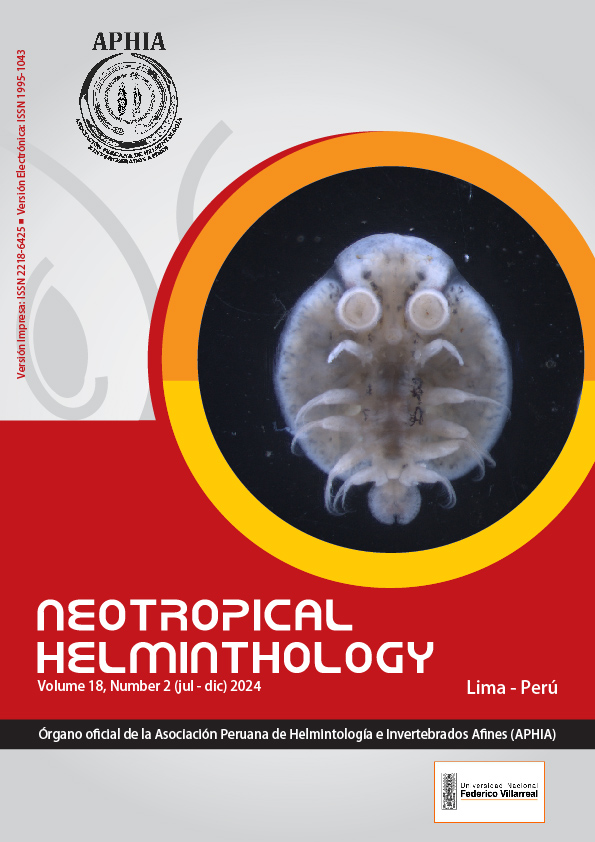Predatory behavior of gambusia punctata (Poey, 1854) on Aedes aegypti (Linnaeus, 1762) larvae based on visual detection in a controlled experimental system
DOI:
https://doi.org/10.62429/rnh20242181834Keywords:
Aedes aegypti, Gambusia punctata, larvae, predation, visual detectionAbstract
The objective was to evaluate the predatory behavior of Gambusia punctata (Poey, 1854) on Aedes aegypti (Linnaeus, 1762) larvae given its visual detection in a controlled experimental system. Two males and eight females of G. punctata were placed in a plastic container with submerged aquatic plants in the first third of the container. For the first three days, 30 A. aegypti larvae were supplied daily. A device was designed to distribute the mosquito larvae uniformly across the container's surface. A vertical plastic sheet was introduced in the second third of the container, restricting the fish to the first third. Four millimeter mesh cylinders were placed near the vegetation, designed to confine two larvae within each cylinder. Predatory response was assessed based on detection time and near-total permanence of the fish close to the cylinders. The experiment was replicated twice. Detection times were similar between replicates (6.01±0.21 s and 6.04±0.18 s), but replicate 1 showed greater variability and lower precision compared to replicate 2, which demonstrated higher consistency. No statistically significant differences were found. It was concluded that G. punctata effectively detects A. aegypti larvae when visible, but detection decreases when larvae are hidden, suggesting the use of other senses. The variability in detection times highlights the influence of experimental factors.
Downloads
Published
How to Cite
Issue
Section
License

This work is licensed under a Creative Commons Attribution-NonCommercial-NoDerivatives 4.0 International License.
OBJETO: El AUTOR-CEDENTE transfiere de manera TOTAL Y SIN LIMITACIÓN alguna al CESIONARIO los derechos patrimoniales que le corresponden sobre la (s) obra(s) tituladas: xxxxxxxxxxxxxxxx, por el tiempo que establezca la ley internacional. En virtud de lo anterior, se entiende que el CESIONARIO adquiere el derecho de reproducción en todas sus modalidades, incluso para inclusión audiovisual; el derecho de transformación o adaptación, comunicación pública, traducción, distribución y, en general, cualquier tipo de explotación que de las obras se pueda realizar por cualquier medio conocido o por conocer en el territorio nacional o internacional.
REMUNERACIÓN: La cesión de los derechos patrimoniales de autor que mediante este contrato se hace será a título gratuito.
CONDICIONES Y LEGITIMIDAD DE LOS DERECHOS: El AUTOR-CEDENTE garantiza que es propietario integral de los derechos de explotación de la(s) obra(s) y en consecuencia garantiza que puede contratar y transferir los derechos aquí cedidos sin ningún tipo de limitación por no tener ningún tipo de gravamen, limitación o disposición. En todo caso, responderá por cualquier reclamo que en materia de derecho de autor se pueda presentar, exonerando de cualquier responsabilidad al CESIONARIO.
LICENCIA DE ACCESO ABIERTO: El AUTOR-CEDENTE autoriza que manuscrito publicado en La Revista Neotropical Helminthology permanece disponible para su consulta pública en el sitio web https://www.neotropicalhelminthology.com/ y en los diferentes sistemas de indexación y bases de datos en las que la revista tiene visibilidad, bajo la licencia Creative Commons, en la modalidad Reconocimiento-No comercial- Sin Trabajos derivados –aprobada en Perú, y por lo tanto son de acceso abierto. De ahí que los autores dan, sin derecho a retribución económica, a la Asociación Peruana de Helmintología e Invertebrados Afines (APHIA), los derechos de autor para la edición y reproducción a través de diferentes medios de difusión.


 Numero 2 Volumen 19 - 2025 (versión Anticipada)
Numero 2 Volumen 19 - 2025 (versión Anticipada)














































